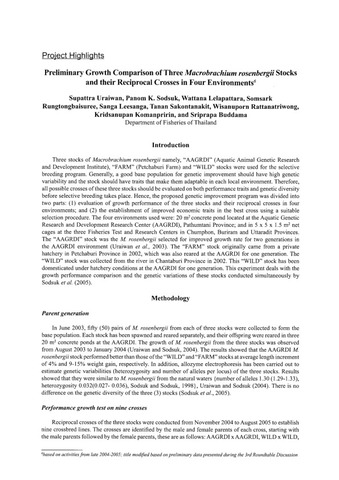Preliminary growth comparison of three Macrobrachium rosenbergii stocks and their reciprocal crosses in four environments
| dc.contributor.author | Uraiwan, Supattra | |
| dc.contributor.author | Sodsuk, Panom K. | |
| dc.contributor.author | Lelapattara, Wattana | |
| dc.contributor.author | Rungtongbaisuree, Somsark | |
| dc.contributor.author | Leesanga, Sanga | |
| dc.contributor.author | Sakontanakit, Tanan | |
| dc.contributor.author | Rattanatriwong, Wisanuporn | |
| dc.contributor.author | Komanpririn, Kridsanupan | |
| dc.contributor.author | Buddama, Sriprapa | |
| dc.date.accessioned | 2020-08-10T06:36:48Z | |
| dc.date.available | 2020-08-10T06:36:48Z | |
| dc.date.issued | 2007 | |
| dc.identifier.citation | Uraiwan, S., Sodsuk, P. K., Lelapattara, W., Rungtongbaisuree, S., Leesanga, S., Sakontanakit, T., Rattanatriwong, W., Komanpririn, K., & Buddama, S. (2007). Preliminary growth comparison of three Macrobrachium rosenbergii stocks and their reciprocal crosses in four environments. In M. R. R. Eguia & M. L. C. Aralar (Comps.), Recent developments in the genetic improvement of the giant freshwater prawn (Macrobrachium sp.) (pp. 38–43). Tigbauan, Iloilo, Philippines: Aquaculture Department, Southeast Asian Fisheries Development Center. | en |
| dc.identifier.isbn | 9789718511848 | |
| dc.identifier.uri | http://hdl.handle.net/10862/5955 | |
| dc.description.abstract | Three stocks of Macrobrachium rosenbergii namely, “AAGRDI” (Aquatic Animal Genetic Research and Development Institute), “FARM” (Petchaburi Farm) and “WILD” stocks were used for the selective breeding program. Generally, a good base population for genetic improvement should have high genetic variability and the stock should have traits that make them adaptable in each local environment. Therefore, all possible crosses of these three stocks should be evaluated on both performance traits and genetic diversity before selective breeding takes place. Hence, the proposed genetic improvement program was divided into two parts: (1) evaluation of growth performance of the three stocks and their reciprocal crosses in four environments; and (2) the establishment of improved economic traits in the best cross using a suitable selection procedure. The four environments used were: 20 m2 concrete pond located at the Aquatic Genetic Research and Development Research Center (AAGRDI), Pathumtani Province; and in 5 x 5 x 1.5 m2 net cages at the three Fisheries Test and Research Centers in Chumphon, Buriram and Uttaradit Provinces. The “AAGRDI” stock was the M. rosenbergii selected for improved growth rate for two generations in the AAGRDI environment (Uraiwan et al., 2003). The “FARM” stock originally came from a private hatchery in Petchaburi Province in 2002, which was also reared at the AAGRDI for one generation. The “WILD” stock was collected from the river in Chantaburi Province in 2002. This “WILD” stock has been domesticated under hatchery conditions at the AAGRDI for one generation. This experiment deals with the growth performance comparison and the genetic variations of these stocks conducted simultaneously by Sodsuk et al. (2005). | en |
| dc.language.iso | en | en |
| dc.publisher | Aquaculture Department, Southeast Asian Fisheries Development Center | en |
| dc.subject | Macrobrachium rosenbergii | en |
| dc.subject | freshwater prawns and shrimps | en |
| dc.subject | Thailand | en |
| dc.subject | reciprocal crossing | en |
| dc.title | Preliminary growth comparison of three Macrobrachium rosenbergii stocks and their reciprocal crosses in four environments | en |
| dc.type | Book chapter | en |
| dc.citation.spage | 38 | en |
| dc.citation.epage | 43 | en |
| dc.citation.bookTitle | Recent developments in the genetic improvement of the giant freshwater prawn (Macrobrachium sp.) | en |
| dc.subject.asfa | stocks | en |
| dc.subject.asfa | allozymes | en |
| dc.subject.asfa | electrophoresis | en |
| dc.subject.asfa | genetics | en |
| dc.subject.asfa | growth | en |
| dc.subject.asfa | length-weight relationships | en |
| dc.subject.asfa | heterosis | en |
| dc.subject.asfa | hybridization | en |
| dc.contributor.compiler | Eguia, Maria Rowena R. | |
| dc.contributor.compiler | Aralar, Maria Lourdes C. |
このアイテムのファイル
このアイテムは次のコレクションに所属しています
-
Recent Developments in the Genetic Improvement of the Giant Freshwater Prawn (Macrobrachium sp.) [14]
A compendium of results from the Collaborative Prawn Genetic Improvement and Seed Production Research Project under the Promotion of Sustainable Aquaculture in the ASEAN Region (2002 - 2007)


